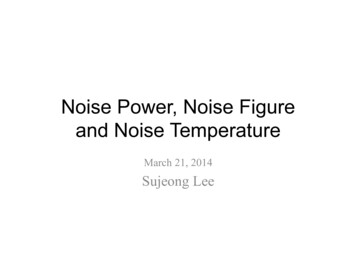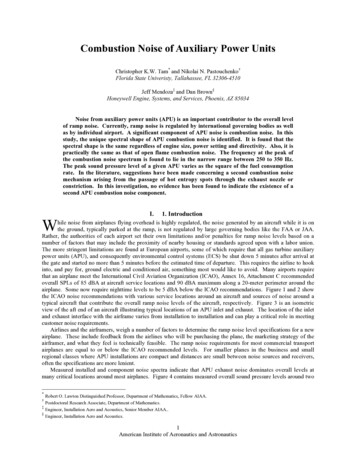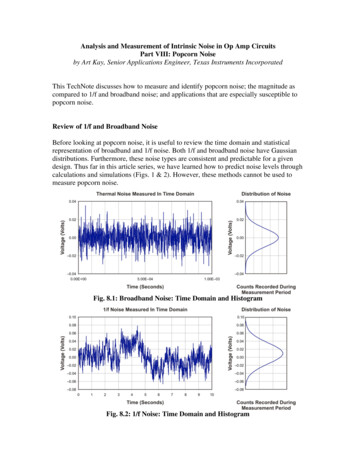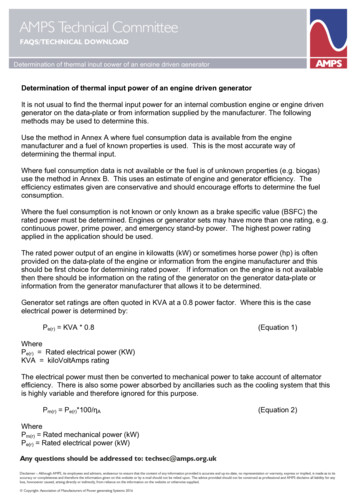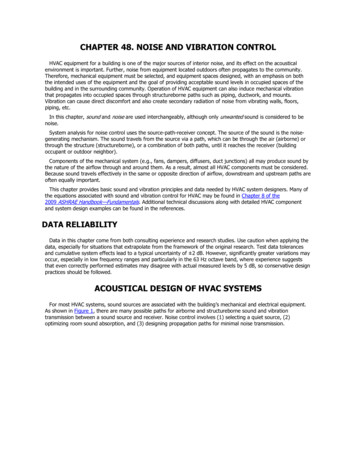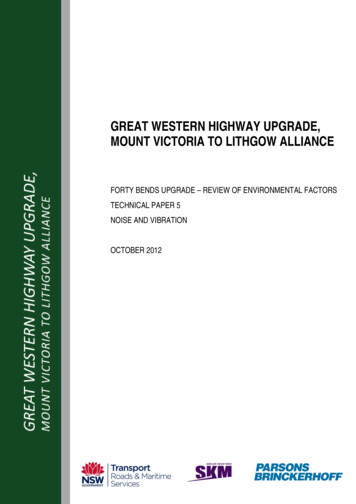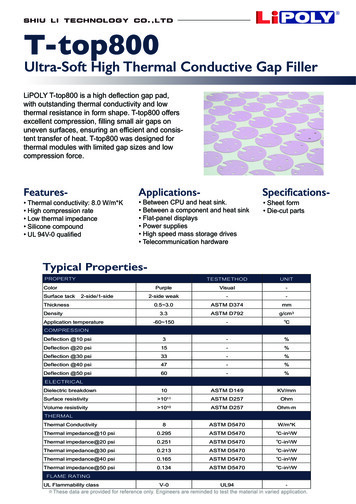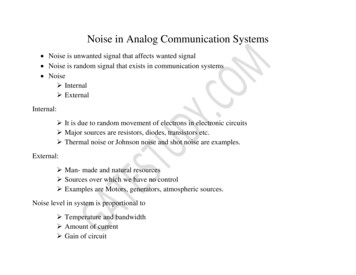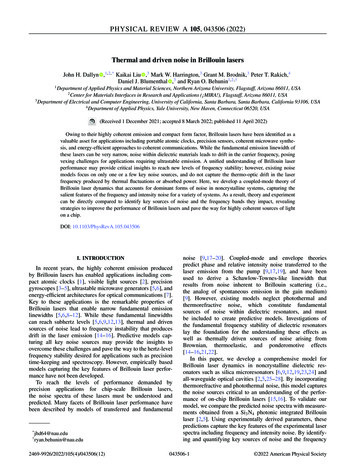
Transcription
PHYSICAL REVIEW A 105, 043506 (2022)Thermal and driven noise in Brillouin lasersJohn H. Dallyn ,1,2,* Kaikai Liu ,3 Mark W. Harrington,3 Grant M. Brodnik,3 Peter T. Rakich,4Daniel J. Blumenthal ,3 and Ryan O. Behunin1,2,†1Department of Applied Physics and Material Sciences, Northern Arizona University, Flagstaff, Arizona 86011, USA2Center for Materials Interfaces in Research and Applications (¡MIRA!), Flagstaff, Arizona 86011, USA3Department of Electrical and Computer Engineering, University of California, Santa Barbara, Santa Barbara, California 93106, USA4Department of Applied Physics, Yale University, New Haven, Connecticut 06520, USA(Received 1 December 2021; accepted 8 March 2022; published 11 April 2022)Owing to their highly coherent emission and compact form factor, Brillouin lasers have been identified as avaluable asset for applications including portable atomic clocks, precision sensors, coherent microwave synthesis, and energy-efficient approaches to coherent communications. While the fundamental emission linewidth ofthese lasers can be very narrow, noise within dielectric materials leads to drift in the carrier frequency, posingvexing challenges for applications requiring ultrastable emission. A unified understanding of Brillouin laserperformance may provide critical insights to reach new levels of frequency stability; however, existing noisemodels focus on only one or a few key noise sources, and do not capture the thermo-optic drift in the laserfrequency produced by thermal fluctuations or absorbed power. Here, we develop a coupled-mode theory ofBrillouin laser dynamics that accounts for dominant forms of noise in noncrystalline systems, capturing thesalient features of the frequency and intensity noise for a variety of systems. As a result, theory and experimentcan be directly compared to identify key sources of noise and the frequency bands they impact, revealingstrategies to improve the performance of Brillouin lasers and pave the way for highly coherent sources of lighton a chip.DOI: 10.1103/PhysRevA.105.043506I. INTRODUCTIONIn recent years, the highly coherent emission producedby Brillouin lasers has enabled applications including compact atomic clocks [1], visible light sources [2], precisiongyroscopes [3–5], ultrastable microwave generators [5,6], andenergy-efficient architectures for optical communications [7].Key to these applications is the remarkable properties ofBrillouin lasers that enable narrow fundamental emissionlinewidths [5,6,8–12]. While these fundamental linewidthscan reach subhertz levels [5,6,9,12,13], thermal and drivensources of noise lead to frequency instability that producesdrift in the laser emission [14–16]. Predictive models capturing all key noise sources may provide the insights toovercome these challenges and pave the way to the hertz-levelfrequency stability desired for applications such as precisiontime-keeping and spectroscopy. However, empirically basedmodels capturing the key features of Brillouin laser performance have not been developed.To reach the levels of performance demanded byprecision applications for chip-scale Brillouin lasers,the noise spectra of these lasers must be understood andpredicted. Many facets of Brillouin laser performance havebeen described by models of transferred and 69-9926/2022/105(4)/043506(12)noise [9,17–20]. Coupled-mode and envelope theoriespredict phase and relative intensity noise transferred to thelaser emission from the pump [9,17,19], and have beenused to derive a Schawlow-Townes-like linewidth thatresults from noise inherent to Brillouin scattering (i.e.,the analog of spontaneous emission in the gain medium)[9]. However, existing models neglect photothermal andthermorefractive noise, which constitute fundamentalsources of noise within dielectric resonators, and mustbe included to create predictive models. Investigations ofthe fundamental frequency stability of dielectric resonatorslay the foundation for the understanding these effects aswell as thermally driven sources of noise arising fromBrownian, thermoelastic, and ponderomotive effects[14–16,21,22].In this paper, we develop a comprehensive model forBrillouin laser dynamics in noncrystalline dielectric resonators such as silica microresonators [6,9,12,19,23,24] andall-waveguide optical cavities [2,5,25–28]. By incorporatingthermorefractive and photothermal noise, this model capturesthe noise sources critical to an understanding of the performance of on-chip Brillouin lasers [15,16]. To validate ourmodel, we compare the predicted noise spectra with measurements obtained from a Si3 N4 photonic integrated Brillouinlaser [2,5]. Using experimentally derived parameters, thesepredictions capture the key features of the experimental laserspectra including frequency and intensity noise. By identifying and quantifying key sources of noise and the frequency043506-1 2022 American Physical Society
JOHN H. DALLYN et al.PHYSICAL REVIEW A 105, 043506 (2022)bands they impact, these results reveal strategies to improvethe performance of Brillouin lasers and pave the way forhighly coherent sources of light on a chip.The paper is organized as follows: Section II describesthe physical origin of the dominant noise sources in noncrystalline Brillouin lasers. Section III outlines the coupled-modetheory capturing the dominant forms of noise. The laser’s amplitude and phase dynamics are derived, including the impactof feedback that locks the pump frequency to the laser resonator. Thermorefractive and photothermal noise are modeledby coupling the optical-mode dynamics with the temperaturefield. We add temperature-dependent optical-mode frequencies to the coupled-mode dynamics and solve the stochasticdynamics of the temperature field that include drive termsassociated with fundamental thermal fluctuations as well asthe heat flux produced by the optical field. Section IV compares model predictions to measured frequency and intensitynoise power spectra for an integrated waveguide Brillouinlaser. This comparison, and quantitative agreement, enablesthe features of the noise spectra to be identified and understood and therefore, through the equations given in Sec. III,to be controlled. Section V summarizes the key results of thepaper.II. SOURCES OF BRILLOUIN LASER NOISEThe performance of noncrystalline Brillouin lasers is determined by spontaneous emission (fundamental noise) [9],noise produced by both fundamental and driven thermal fluctuations, and noise transferred from the pump laser. In thissection, we describe the qualitative nature and physical originof each of these noise sources. In later sections, we show howthese noise sources are modeled and provide expressions forderived frequency and intensity noise power spectra.Fundamental noise is inherent to the laser amplification process. For a Brillouin laser, this noise is producedby spontaneous Stokes emission from thermally populatedphonon modes. This effect has been explored in modelsutilizing coupled modes [9,18] and envelopes [19], wherea Schawlow-Townes-like linewidth describes the frequencynoise [9] and the intensity fluctuations exhibit relaxation oscillations [18,19].Thermorefractive noise occurs when temperature fluctuations within a dielectric resonator lead to local shifts in theindex of refraction through the thermo-optic effect as seen inFig. 1(d). Consequently, a fluctuation in temperature can shiftthe resonant frequencies of a cavity [14], illustrated by thepath from Fig. 1(d) to Fig. 1(a). Because this noise sourcescales with the inverse resonator mode volume, thermorefractive noise can be a critical form of frequency instability withinmicroresonators.Photothermal noise results from frequency fluctuationsoriginating from thermo-optic shifts in the index of refractionthat are driven by optical absorption of fluctuating intracavitypower [Fig. 1(c) to Fig. 1(d)]. These power fluctuations arisefrom both fundamental amplitude noise of both pump andStokes modes within the resonator as well as relative intensitynoise (RIN) present in the source laser used to drive Brillouinlasing, Fig. 1(b).FIG. 1. (a) Physical origins of thermo-optic noise in a stimulatedBrillouin scattering (SBS) laser with resonant frequency f0 . (b) Thepump laser power noise (relative intensity noise, RIN) injects relativepower shifts, δPp , into the resonator. (c) These pump fluctuations, andthe Stokes mode’s power fluctuations, are absorbed by the resonator.(d) Intrinsic temperature fluctuations, the source of thermorefractivenoise, and temperature fluctuations from the absorbed power, thesource of photothermal noise, change the index of refraction. Thisperturbs the resonant frequency (δ f ), adding noise to the laser.Transferred pump noise can be imprinted on the Brillouinlaser emission. While stimulated Brillouin scattering (SBS) isknown for producing laser emission with noise that is drastically compressed compared to the pump, this filtering abilityis ultimately limited by relative decay rates of the optical andacoustic modes [17]. In addition, RIN of the pump also drivesintensity fluctuations of SBS emission, impacting the powerstability and leading to one source of photothermal noise.Other noise sources are present within Brillouin lasers andrequire careful analysis in systems, such as microtoroids orcrystalline resonators, where radiation pressure and thermalexpansion are significant compared to the thermo-optic effect. These ponderomotive and thermoelastic effects as wellas Brownian motion of the resonator structure are smallcompared to the noise sources described above within thenoncrystalline SBS lasers considered here [15,16].III. THEORYTo model Brillouin laser dynamics, we use a coupled-modetheory, treating the optical and acoustic modes as mean-field(lumped) elements [9,18]. The validity of this model requiresthat the temporal changes in the electric field amplitude, theloaded optical decay rate, and the gain bandwidth are all muchsmaller than the free spectral range and relevant resonancefrequencies of the resonator; i.e., intermodal scattering is negligible and the rotating wave approximation (RWA) is valid.Owing to the relatively large strength of electrostriction, weneglect effects produced by the Kerr nonlinearity, i.e., selfand cross-phase modulation, for example, valid for reasonable intracavity powers in silica resonators ( 100 mW), andrelatively small refractive indices. All theory presented in thefollowing section is generalized so that it is independent ofthe material and geometry that the noncrystalline SBS laserconsists of.Under these assumptions, Brillouin laser dynamics canbe modeled using the Hamiltonian H H0 Hint where H0043506-2
THERMAL AND DRIVEN NOISE IN BRILLOUIN LASERSPHYSICAL REVIEW A 105, 043506 (2022)describes the uncoupled dynamics of the pump, Stokes, andphonon modes,H0 h̄ω p a†p a p h̄ωS aS† aS h̄ b† b,(1)and Hint quantifies the coupling of these modes through electrostriction,Hint h̄ga†p aS b h̄g b† aS† a p ,(2)where we neglect the effect of cascaded-order lasing. Here,ω p , a p , and a†p (ωS , aS , and aS† ) denote the pump (Stokes) frequency and annihilation and creation operators, respectively,while , b, and b† are the phonon mode frequency and annihilation and creation operators. The parameter g is a couplingrate quantifying the electrostrictive interaction between thepump, Stokes, and phonon modes which is determined fromthe spatial overlap of the acoustic and optical modes and thephotoelastic tensor [18].Using this Hamiltonian and adding the effects of opticaland acoustic dissipation as well as an external pump, wederive equations of motion for the SBS laser. Under the assumption that pump, Stokes, and phonon modes are phasematched, i.e., ω p ωS , we find Heisenberg-Langevinequations of motion, evaluated in a rotating frame about theresonance frequency of each field, given by ȧ p 21 γ p a p igaS b γext Fext η p ,(3)ȧS 21 γS aS ig b† a p ηS ,(4)ḃ 21 b ig aS† a p ξ ,(5)where , γ p , and γS are the respective acoustic, pump, andStokes mode decay rates, and η p , ηS , and ξ are the Langevinforces for the optical and acoustic modes. For consistencywith thermodynamics, these losses and Langevin forces returnthe perturbed system to thermal equilibrium in the absenceof electrostrictive coupling and external driving, and are consistent with the fluctuation-dissipation theorem in the limit ofvalidity for the RWA. The external decay rate γext accounts forthe optical losses that occur when the laser resonator is coupled to a bus waveguide and quantifies the fraction of suppliedpump power that can excite the resonator. The time-dependentcomplex amplitude Fext accounts for the effects of the pumplaser, including noise, and is normalized so that the on-chippump laser power can be represented by Pp h̄ω p Fext 2 .The Langevin forces η p , ηS , and ξ capture the quantum andthermal fluctuations of the optical and acoustic fields, respectively, and can be modeled by zero-mean Gaussian variableswith white power spectra [9,18,19]. The two-time correlationproperties for these force are given by ηm† (t )ηm (t ) γm Nth,m δ(t t )δmm ,(6) ηm (t )ηm† (t ) γm (Nth,m 1)δ(t t )δmm ,(7) ξ † (t )ξ (t ) nth δ(t t ),(8) ξ (t )ξ † (t ) (nth 1)δ(t t ),(9)tical and acoustic modes, respectively, T0 is the temperature,and h̄ and kB are the Planck and Boltzmann constants.A further simplification of these dynamics can be obtainedwhen the phonon decay rate far exceeds the optical decay rates( γm ). Under these conditions, the phonon field amplitudecan be obtained in the quasistatic limit where the amplitudesa p and aS evolve slowly compared to , givingb b̂ i2g †a a p, S(10)where b̂ quantifies the thermal and quantum fluctuations of thephonon field: b̂ t dτ e 2 (t τ ) ξ (τ ).(11)This approximation holds for frequencies significantly smallerthan the phonon decay rate. In Appendix A, we show that theleading-order correction to Eq. (10) captures the frequencynoise transferred from the pump laser.Inserting Eq. (10) into Eqs. (3) and (4), we find the effectiveSBS laser equations of motion,ȧ p 21 γ p a p μaS aS† a p γext Fext h p ,ȧS 21 γS aS μa†p a p aS hS ,(12)(13)where μ 2 g 2 / , quantifying the Brillouin coupling, isproportional to the Brillouin gain [29], and h p η p igaS b̂ and hS ηS ig a p b̂† are “phonon-dressed” Langevinforces. We have neglected the effect of spontaneous emissionon the pump decay rate [18]. These forces describe how quantum and thermal fluctuations of the optical and mechanicalmodes impart colored multiplicative noise on the optical fieldsthrough electrostriction. While these approximations reproduce much of the key physics of Brillouin lasers, one mustretain the first-order corrections to the quasistatic approximation taken above in Eq. (10) to recover the line-narrowingproperties of Brillouin lasers described by Debut et al. (seeAppendix A) [17].A. Fundamental and driven thermal noiseTo model thermo-optic noise, we add the stochastic heatequation to our model, accounting for fundamental and optically driven thermal fluctuations, and include the impact ofthese thermal fluctuations on the laser dynamics. To capturethe latter, we add a zero-mean fluctuating frequency ω̂ j to thelaser equations of motion that is driven by the mode-volumeaveraged temperature field. This modification does not affectthe previous adiabatic elimination to a linear order expansionof the optical beat note, given that ω̂ p and ω̂S are approximately equal, which is valid for a large class of resonators.With these modifications, Eqs. (12) and (13) becomeȧ p ( iω̂ p γ p /2)a p μaS aS† a p where Nth,m (exp( h̄ωm /kB T0 ) 1) 1 and nth (exp( h̄ /kB T0 ) 1) 1 are the thermal occupation numbers of the op043506-3 γext Fext h p , (14)ȧS ( iω̂S γS /2)aS μa†p a p aS hS ,(15)
JOHN H. DALLYN et al.PHYSICAL REVIEW A 105, 043506 (2022)where ω̂ j , derived using modal perturbation theory, is givenby ωjdnω̂ j E0 (x) 2 T (t, x).(16)d 3xngdTHere, ng is the group index, dn/dT is the thermo-optic coefficient, E0 is the volume-normalizedelectric field strength in the cavity (i.e., d 3 x E0 2 1), and T (t, x) representstemperature fluctuations about equilibrium [14]. The solutionto the driven heat equation given byρC Ṫ (t, x) · κ T (t, x) ζ (t, x) q̇opt(17)provides T (t, x), where κ is the thermal conductivity, Cis the specific heat capacity at constant volume, ρ is themass density, ζ (t, x) is a zero mean Langevin force drivingfundamental thermal fluctuations according to the fluctuationdissipation relation (see Ref. [14]), and q̇opt describes the heatflux density produced by fluctuating optical power within theresonator [29]. Here, q̇opt captures all changes in temperatureproduced by the presence of optical energy, e.g., absorption or electrostriction plus mechanical dissipation. Together,Eqs. (14), (15), and (17) provide a unified description of thekey physics that determine SBS laser dynamics in noncrystalline media (generalization to crystalline materials requiresthe inclusion of thermal expansion). A rigorous treatment ofthermal expansion requires a treatment of the laser resonator’sthermally driven mechanical motion as well as a modificationof Eq. (16) to include changes in the laser resonator broughtabout by thermal deformations of the waveguide geometry.These effects must be included in systems where thermalexpansion cannot be neglected.B. Amplitude and phase decompositionTo explore the noise dynamics of the SBS laser describedby Eqs. (14), (15), and (17), we decompose a p and aS in termsof phase and amplitude expressed bya p (α p δα p )e ,(18)aS (αS δαS )e .(19)iϕ piϕSHere α p and αS are time-independent, steady-state amplitudesof the pump and Stokes mode, δα p and δαS represent fluctuations about the steady-state amplitude, and ϕ p and ϕS aretime-dependent fluctuating phases of the optical modes. Thesteady-state amplitudes for the pump and Stokes modes (for asingle-order Brillouin laser above threshold) are given by (seeRef. [18])γSα 2p ,2μ γext Fext γ p12αS .μαp2(20)(21)We obtain the amplitude and phase dynamics by insertingEqs. (18) and (19) into Eqs. (14) and (15), linearize to firstorder in fluctuating amplitude δα (assuming α δα), andTABLE I. Table of parameters for a Si3 N4 waveguide resonator[2]. The coupling rate g, acoustic decay rate , and optical decayrates γ p,S are the same for the pump and Stokes mode.g γextγ p,SμLσrσzQLαabsPextPextPSdn/dTρ1.54 kHz(2π )150 MHz(2π )3.9 MHz(2π )6.8 MHz5.1 mHz0.072 m2.8 μm0.85 μm28.5 1060.035 m 10.042 W0.025 W0.006 W0.87 10 5 [21]2300 kg m 3C1000 J (kg K) 1κνg0.008472.06 108 m/sElectrostrictive coupling ratePhonon decay rateExternal optical decay rateLoaded optical decay rate1/2 Brillouin amplification rateResonator lengthRadial mode widthVertical mode widthLoaded quality factorAbsorption factorFrequency noise on-chip powerRIN on-chip powerStokes powerThermo-optic coefficientPlasma-enhanced chemical vapordeposition (PECVD) silicon dioxidedensityThermal silicon dioxideSpecific heat capacityPower couplingOptical group velocityisolate real and imaginary parts, yielding equations for thephase and amplitude of each mode: γext1Im[F̃ext ],(22)ϕ̇ p ω̂ p Im[h̃ p ] αpαp1(23)ϕ̇S ω̂S Im[h̃S ],αS γext Fext δ α̇ p δα p 2μαS α p δαS Re[h̃ p ]αp γext (Re[F̃ext ] Fext ),(24)δ α̇S 2μα p αS δα p Re[h̃S ],(25)where h̃ p h p exp( iϕ p ), h̃S hS exp( iϕS ), and F̃ext Fext exp( iϕ p ). Because the coupling parameter μ is real whenperfect phase matching is satisfied, the phase and amplitudedynamics decouple and can be analyzed independently. WhileEq. (22) describes the free running dynamics of the phase ofthe optical mode driven by the pump laser ϕ p , in practice thepump laser is locked to the SBS resonator using a feedbackloop. Using a control theory model for this feedback loop,shown in Appendix B, the impact of this form of laser controlcan be determined. For the experimental case explored in thispaper, where the SBS resonator linewidth is large comparedto the pump laser linewidth (see Table I), ϕ̇ p ω̂ p ξext ,where ξext is a Langevin force modeling phase diffusionand the linewidth of the pump laser. Under this same case,the thermal effects described by Eq. (16) can be ignored inEqs. (24) and (25).In the following sections, we use the dynamics describedby Eqs. (22)–(25) to model the frequency and intensity noiseof a SBS laser.043506-4
THERMAL AND DRIVEN NOISE IN BRILLOUIN LASERSPHYSICAL REVIEW A 105, 043506 (2022)fluctuations of the pump laser, to yieldC. Relative intensity noiseRelative intensity noise, produced by fluctuations of theamplitudes δα p and δαS , leads to instability in the emittedlaser power. Equations (24) and (25) show that the RIN ofthe Stokes mode has two sources: amplitude noise transferredfrom the pump laser and fundamental fluctuations inherentto Brillouin scattering [19]. Even for an ideal pump laser(i.e., power stable), spontaneous Brillouin scattering is alwayspresent, leading to amplitude noise.The RIN can be expressed as an amplitude power spectraldensity (PSD), using Eqs. (24) and (25) and δPS 2PS δαS /αS[18] we findSSRIN [ω] 4αS2 8 αS2 2RINdτ eiωτ δαS (t τ )δαS (t ) .(26)1 2 iω R ω2 α 2 2S RIN (Re[h̃ p [ω]] δ f [ω]) ( iω R )Re[h̃S [ω]]. ω2 iω R 2RIN(27)When Eq. (27) is inserted into Eq. (26), the first-order StokesSBS laser RIN is described by the summation of two PSDs(assuming no cross-correlations, i.e., pump power fluctuationsare independent of fundamental fluctuations h̃S [ω]δ f [ω ] 0) given byRINγext Pext RINSext [ω]. (30) 2 iω R ω2 h̄ωext 2RINRINRIN[ω] and Sext[ω] are both single-sided PSDs.Here, StransIn addition to the PSD describing the intensity fluctuationsof the SBS laser, fluctuations of the total intracavity power arecritical to calculate the photothermal noise (Sec. III D 3). Thetotal intracavity power Ptot and fluctuations in the total power,δPtot , are given byh̄ω0 vg 2α p αS2 ,Lh̄ω0 vg[2α p δα p 2αS δαS ],δPtot LPtot (31)(32)where second-order terms in fluctuating amplitudes have beenneglected. The PSD for the total RIN, relevant to photothermalnoise calculated in Sec. III D 3, is given by 1RINStot [ω] 2dτ eiωτ δPtot (t τ )δPtot (t ) .(33)Ptot This equation accounts for the transferred and fundamentalsources of RIN for both the pump mode and the Stokes modeas well as cross-correlations between pump and Stokes amplitude fluctuations (i.e., δα p δαS 0) [18]. The expression forRINStotis given in Appendix E.(28)where δ f [ω]δ f [ω ] andcontains correlationterms of Re[h̃ p [ω]], Re[h̃S [ω]], and cross-correlation betweenthe two. These two terms represent intensity noise producedby spontaneous scattering inherent (fundamental) to Brillouinlasing and by instability in the pump laser power (transferred).In agreement with prior work (see Refs. [18,19]), we findRIN) contribution to the RINthe (single-sided) fundamental (Sfundgiven byRINStransRINSfund g 2 (1 2nth ) γS [(γ p R )2 ω2 ] 1 (1 2Nth ) γS R2 ω2 γ p 2RIN222μ( 4ω )4exhibiting a relaxation oscillation peak near RIN . To connectwith experiment we express the pump-transferred contributionto the intensity noise in terms of the (measurable) pump RINRINRIN). Stranscan be expressed as(SextRINStrans[ω] RINRINSSRIN [ω] Sfund[ω] Strans[ω], To obtain an explicit expression for Eq. (26), we solveEqs. (24) and (25) in the Fourier domain, and use the sub stitutions R γext Fext /α p , RIN 2μα p αS , and δ f γext (Re[F̃ext ] Fext ), the latter representing amplitudeRINSfund[ω] δαS [ω], (29)D. Brillouin laser frequency noiseTo model the frequency stability of noncrystalline chipintegrated SBS lasers, we analyze the four dominant sourcesof frequency noise: fundamental noise intrinsic to the physicsof SBS lasing, transferred frequency noise from the pumplaser, photothermal noise, and thermorefractive noise. Owingto the distinct physical origins of each of these effects, weassume that these noise sources are uncorrelated and that thepower spectrum is given by the sum of PSDs for each of theseprocesses:PTtransS f [ω] S fund[ω] S TR[ω],ff [ω] S f [ω] S f(34)PTtrans[ω], S TR[ω] respectivelywhere S fundff [ω], S f [ω], and S fdenote the PSD for the fundamental, thermorefractive, photothermal, and transferred noise. In the following sections, wecharacterize the PSD for each of these noise sources. Thefundamental and transferred pump frequency noise can bederived directly from our coupled-mode model, whereas thethermorefractive and photothermal noise require an analysisof the heat equation that depends on the geometry of theresonator.1. Fundamental SBS noiseThe fundamental noise can be derived using Eq. (23) whenω̂S (thermal and power-driven frequency fluctuations) is neglected, yielding a Schawlow-Townes-like linewidth whosetwo-sided frequency PSD is described by γS 2 /4fund(nth 1/2) .S f [ω] (Nth 1/2) 2ω 2 /44π 2 αS2043506-5(35)
JOHN H. DALLYN et al.PHYSICAL REVIEW A 105, 043506 (2022)The derivation of this result is described in previous works[5,6,13,18,24]. Being intrinsic to Brillouin lasing, the fundamental noise sets the ultimate performance limits of an SBSlaser.2. Transferred frequency noiseWhile the SBS emission linewidth can be several orders ofmagnitude smaller than the pump laser linewidth, the noisetransferred from the pump can be significant. To capture theeffect of transferred noise, adiabatic elimination of the phononmodes must be relaxed. Keeping first-order corrections (asoutlined in Appendix A), we findγS2 ext(36)S [ω] 2 fin agreement in the low-frequency limit with Ref. [17] andRef. [30] when the cavity finesse is high. S extf [ω] is the frequency noise of the external pump.S trans[ω] f3. Thermorefractive and photothermal noiseAt the scale of integrated photonics, certain noise limitsarise due to the size of the system that are not present inlarger-scale designs. At such small system volumes, thermalfluctuations become more acute, perturbing the frequenciesof a resonator through the couplings between temperatureand optical properties. In noncrystalline systems there aretwo main sources of thermally driven frequency instabilityto be considered: thermorefractive and photothermal noise.Thermorefractive noise is caused by intrinsic thermodynamicfluctuations of the temperature within a resonator that perturbthe refractive index, while photothermal noise is produced byrefractive index changes driven by absorption of a fluctuatingoptical field. Other noise sources can be significant in microphotonic systems as well; examples include thermoelastic,Brownian, and ponderomotive noise. While these latter effectscan be important in crystalline systems, they are negligible incomparison to thermorefractive and photothermal effects inthe systems considered here.We derive the effects of thermal fluctuations on laserfrequency by solving the stochastic heat equation [14,16].The foundation of this approach is derived from the thermodynamic relation between the zero-mean temperaturefluctuations T 2 and the volume of the resonator, V : T 2 kB T02.ρCV(37)We model fluctuations in the thermal field using Eq. (17)[14,31,32], describing thermorefractive and RIN-driven photothermal sources of frequency noise. To approximate theimpact of the optical power on the thermal field, we expressq̇opt in terms of the fluctuations in the absorbed power withinthe resonator given byq̇opt αabs L E0 (x) 2 δPtot (t ),(38)where αabs is the spatial decay rate of the optical modesproduced by absorption, L is the resonator length, and δPtot (t )are the fluctuations of optical power within the resonator [29].In the latter, we neglect the effect of group delay, valid whenthe round-trip time is short compared to the characteristictime changes in the power. Additionally, this particular formfor the absorbed power assumes that the spatial distributionof the optical intensity over the waveguide cross section (butnot the overall power) does not change for translationsalong the waveguide and neglects the impact of changes intemperature brought about through electrostrictively drivenmechanical dissipation or thermal expansion.Following Ref. [14] and generalizing to nonhomogeneoussystems, i.e., appropriate for waveguides comprised of multiple materials, ζ has the correlation properties given by ζ (t, x)ζ (t , x ) 2kB T02 · κ δ 3 (x x )δ(t t ), (39)where T0 is the equilibrium temperature, and · κ acts onx in the δ function. While these correlation properties arenot derived from first principles, they are consistent with thefluctuation-dissipation theorem [14,33], ensuring consistencywith thermodynamics, and correctly reproducing Eq. (37). Bynormalizing to steady-state power, the correlation propertiesof the total intracavity power δPtot are described by Eqs. (29),(30), and (33), including power fluctuations of both pump andStokes modes (see Appendix E).Using an eigenfunction expansion, we solve Eq. (17), expressing the temperature fluctuations in terms of heat “modes”that depend on the geometry and materials of the SBS resonator. The solution for the temperature field can be brokeninto two components T TTR TPT , one quantifying fundamental thermal fluctuations [TTR , i.e., see Eq. (37)] anda second describing temperature changes brought about byabsorbed power (TPT ). Formally, TTR and TPT can be expressedas t TTR (t, x) dτ d 3 x e λμ (t τ ) ϕμ (x )ϕμ (x)TPT (t, x) μ ζ (τ, x )(40) αabs L E0 (x ) 2 δPtot (τ ),where the eigenfunctions ϕμ (x) satisfy the self-adjoint eigenvalue equation · κ ϕμ (x) ρCλμ ϕμ (x),(41)determining the real eig
strategies to improve the performance of Brillouin lasers and pave the way for highly coherent sources of light on a chip. DOI: 10.1103/PhysRevA.105.043506 I. INTRODUCTION In recent years, the highly coherent emission produced by Brillouin lasers has enabled applications including com-pact atomic clocks [1], visible light sources [2], precision
